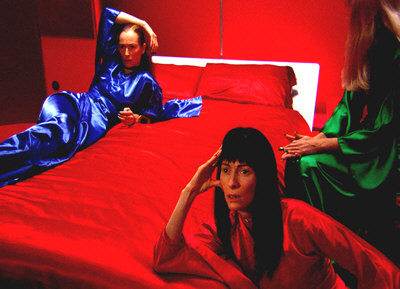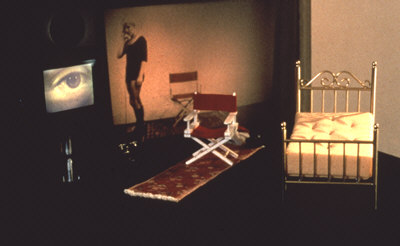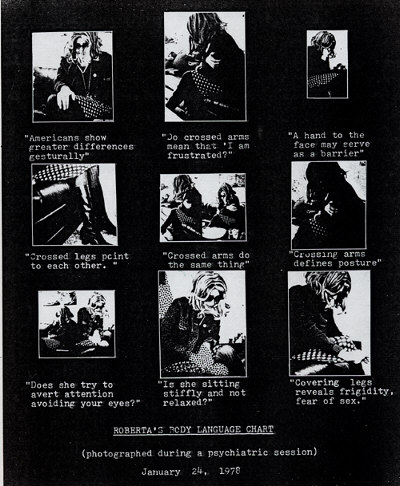Per Contra Winter 2006-2007
Lynn Hershman Leeson, The Per Contra Interview by Miriam N. Kotzin
Thank you for agreeing to do this interview. I’m delighted to have the chance to hear more from you about your work.
MK: In an interview with Dan Epstein in Underground Online you summarized what you’re doing: “I do computer-based installations, sculpture and photography, and it's all the same. You're dealing with issues of identity, of surveillance, the pervasiveness of media and the form only makes it look different. But it's always fun to learn something new.”
I’m interested in your phrase “dealing with,” which seems somewhat neutral, while your work is emotionally charged. Do you see some aspects of your work as feminist? or otherwise political? If so, how?
LHL: I absolutely think of all my work as activist, political and feminist.
My brain was rewired from living through Berkeley in the 60’s. Time is too precious to do work that does not push boundaries towards the persistent dreams of equity, tolerance and sustainability.
MK: Last August you were a part of the 13th International Symposium of Electronic Arts (ISEA2006), “Zero One Jose, International Art On the Edge.” That was your film in-progress, “Strange Culture.” Would you tell our readers a bit about the film and what it’s based on? What was it about Steve Kurz’s and Robert Ferrell’s story that compelled you to do this film?
LHL: The film is about the case of Steve Kurtz and Robert Ferrell. On May 11, 2004 Kurtz’s wife of 27 years died of heart failure. He called 911. The medic saw his art work and called the police, who then called the FBI, who called the hazmat unit and confiscated his wife’s body. Hours later, Kurtz was charged with bio-terrorism, as was his collaborator, a geneticist, Dr. Robert Ferrell. The story is about freedom of speech, first amendment rights and the growing erosion of autonomy in our culture. Tilda Swinton, Thomas Jay Ryan, Steve and Peter Coyote are in it.
MK: Is this the major project you’re working on now? How did you get to this? How would you describe its connection to your other work?
LHL: Although I’ve been in exhibitions with Critical Art Ensemble, what really linked me to it was the injustice, intolerance, ignorance, and consequently the growing and pervasive culture of fear that was moving into our lives, all of our lives. To not speak up about it is, to me to be part of the system.
MK: Your undergraduate work was in education, museum administration and fine arts from Case Western Reserve. What sort of work did you envision yourself doing? Something in art, yes, but what? You got your degree in l963, so, as I remember, projects like Agent Ruby (2002) or Paranoid Mirror (l995), wouldn’t have been possible.
LHL: I’ve always felt I could not ever do anything except my art. I did get the degrees but to my mind, I was unemployable.
MK: It’s ironic that you were studying museum administration when museums weren’t all open to the work you were doing—part of the reason you chose your topic for your masters essay, a subject I’d like to return to in another question. What did you learn in those studies that you were able to use in your career as an artist?
LHL: I don’t know that I learned anything practical, but I spent a lot of time in the library learning about Cezanne, Rembrandt, and the museums, learning about many, many artists, and that was terrific.
MK: Your masters project at San Francisco State 1972 is probably one of the more famous master’s projects—three publishing art critics you created, all of whom found Lynn Hershman’s art something to write about. Prudence Juris, Gay Abandon and Herbert Goode. You’ve said that one of these personae even had an editorship at Artweek? Have you ever been tempted along the way to revive one or more of these critics?
LHL: I’ve been tempted to take on other names because now people know me and I don’t have access, but for the reverse reasons from when I began.
MK: Why is that?
LHL: Some places I’ve already won prizes and I am disqualified from winning more. So a new identity would be appropriate. I’ve received very little funding, especially from grants, but people think I have and I’ve been turned down a few times because people thought I was too well known, that kind of thing. Per Contra is helping by existing and doing what you are doing.
MK: Thanks for the kind words, Lynn. By the way, did you ever let the editors of the publications in on the secret, or did these three critics just vanish?
LHL: The editors of the publications never knew, but then again, why did they need to?
MK: The publications must have missed the contributions. Two of the critics were given women’s names—but were “they” asked if Gay Abandon and Prudence Juris were pen names? Could you let us read a paragraph or two of the arguments they had about Lynn Hershman’s work?
LHL: Gee, I’d have to go to my office to get those reviews, don’t have any on hand.
MK: Who was your advisor for that project? Did your advisor’s openness to the project influence you in your own teaching?
LHL: It was someone in the art education department, who, I think, did not really understand what I was doing.
MK: How has writing been a part of your work? Roberta Breitmore (l974-78) kept a journal? Where is the journal?
LHL: In the collection of Donald Hess.
MK: In an interview with D.L Alvarez in Filmmaker you identified two sources for Roberta Breitmore’s name. Have you ever written to Joyce Carol Oates [whose short story, “Passions and Meditations” included a character, Roberta Bright]? Who was the person who wrote on alchemy that influenced you? How did you get interested in alchemy?
LHL: Alchemy came from my friendship with Arturo Schwartz, the surrealist expert and the dealer of Man Ray and Duchamp. He was the one who really was my mentor.
MK: I can see how alchemy would have fascinated you and been connected to a work in which you created Roberta, but that would be an assumption—so instead of my own reading meaning into it, what is the connection between alchemy and Roberta Breitmore?
LHL: Roberta’s life was a reflection of states of transformation, phases towards her enlightenment, and her growing awareness that she was a mirror of culture.

Protein

Room

Roberta's Body Language